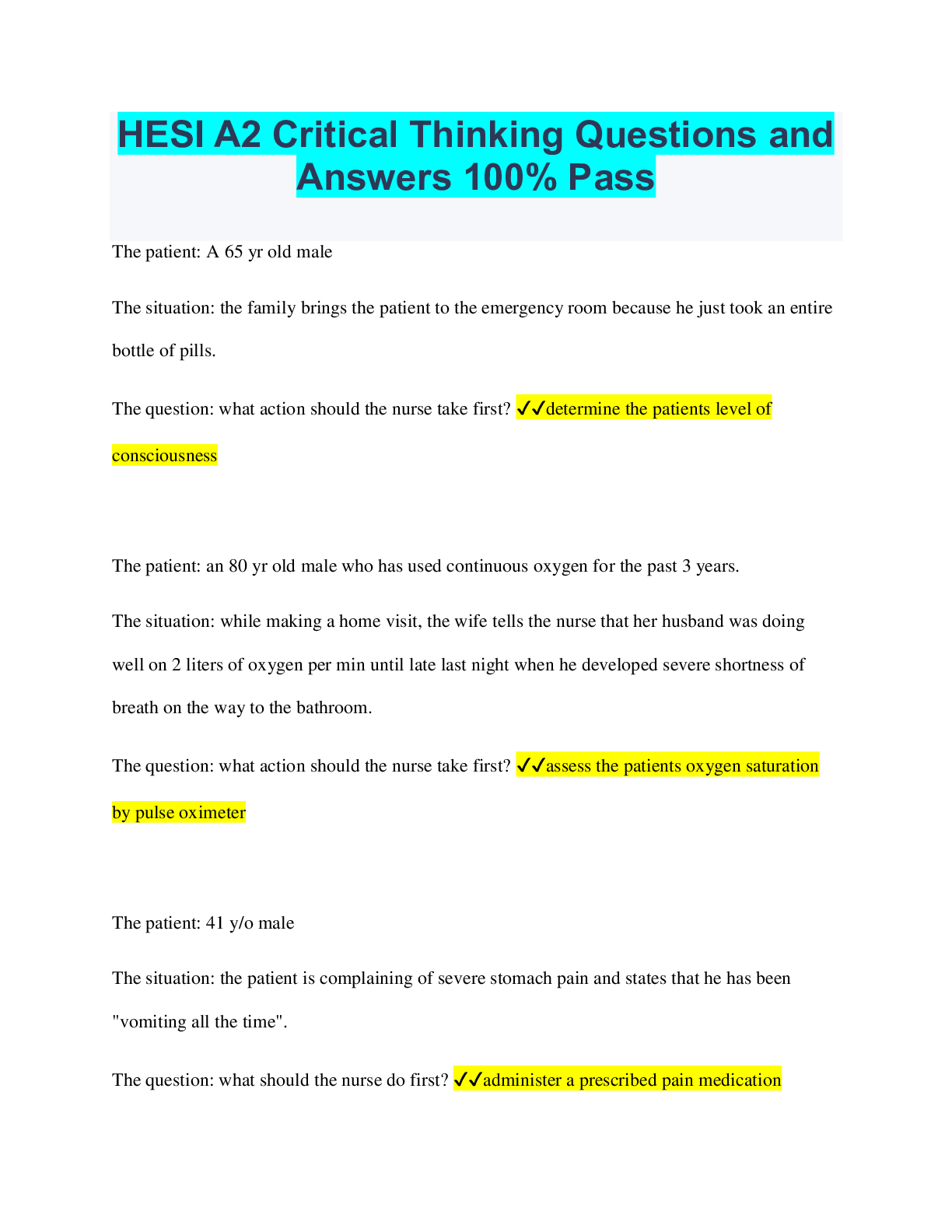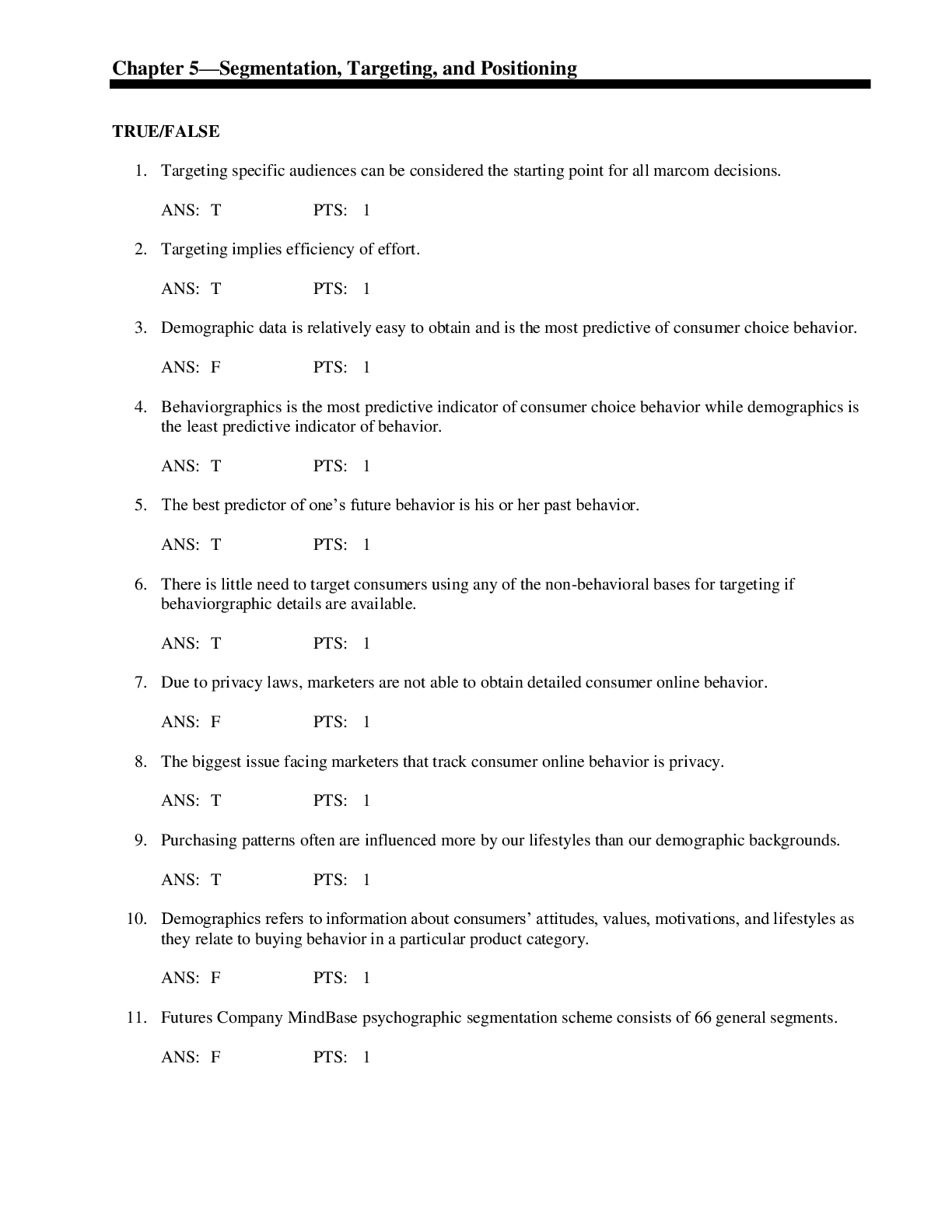Education > QUESTIONS & ANSWERS > Pearson - Foundations of Reading Questions and Answers Graded A+ (All)
Pearson - Foundations of Reading Questions and Answers Graded A+
Document Content and Description Below
Pearson - Foundations of Reading Questions and Answers Graded A+ Guided or Supported Reading ✔✔A method by which an experienced reader provides structure and purpose, and models strategies in o... rder to move beginning readers towards independence. High Frequency Words ✔✔A small group of words (300-500) that account for a large percentage of words in print and can be regular or irregular words. Often, they are referred to as "sight words" since automatic recognition of these words is required for fluent reading. Homograph ✔✔Words that are spelled the same but have different origins and meanings. They may or may not be pronounced the same (e.g., can as in metal container or can as in able to). Immediate Intensive Intervention ✔✔Instruction that may include more time, more opportunities for student practice, more teacher feedback, smaller group size, and different materials. It is implemented as soon as assessment indicates that students are not making adequate progress in reading. Independent Reading Level ✔✔The level at which a reader can read text with 95% accuracy (i.e., no more than one error per 20 words read). Independent reading level is relatively easy text for the reader. Independent-Instructional Reading Level Range ✔✔The reading range that spans instructional and independent reading levels or level of text that a student can read with 90% to 95% or above accuracy. Inference ✔✔Drawing meaning from a combination of clues in the text without explicit reference to the text. "The sky was dark and cloudy so I took my umbrella." We can infer that it might rain even though the text does not say that. Informal Assessment ✔✔Does not follow prescribed rules for administration and scoring and has not undergone technical scrutiny for reliability and validity. Teacher-made tests, end-of-unit tests and running records are all examples of informal assessment. Informational Text ✔✔Nonfiction books, also referred to as expository text, that contains facts and information. Invented Spelling ✔✔An attempt by beginning writers to spell a word when the standard spelling is unknown, using whatever knowledge of sounds and visual patterns the writer has. Inversions ✔✔Reversal or "flipping" of letters either horizontally or vertically, i.e.: p-d, or b-d, m-w, u-n. Not unusual for Emergent readers or writers. Language Experience Approach ✔✔A method of teaching reading by using the reader's own dictated language. Language Structure ✔✔The organization of words (both spoken and written) into meaningful segments (phrases or sentences) using conventions of grammar and syntax. Letter Combinations ✔✔Also referred to as digraphs, a group of consecutive letters that represents a particular sound(s) in the majority of words in which it appears (ai in maid, ch in chair, ar in car). Letter Recognition ✔✔The identification of individual letters by name and/or sounds in a variety of contexts. Letter-Sound Correspondence ✔✔Making a connection between individual letters and the sounds they represent (graphophonics). Linguistic Approach ✔✔A reading based on highly regular spelling patterns. Such as: Nat the cat sat on the mat. Literal Comprehension ✔✔Understanding of the basic facts that the student has read. Main Idea ✔✔The central thought or message of a reading passage. Miscue ✔✔Any substitution of a word in a text that a reader makes. Miscue Analysis ✔✔An examination of reading errors or substitutions (miscues) as the basis for determining the strengths and weaknesses of students' reading skills. Modeled Reading ✔✔An experienced reader's oral reading of a text to aid students in learning strategies, understanding intonation and expression, and the use of punctuation, among other aspects of reading. Modeling ✔✔Teacher overtly demonstrates a strategy, skill, or concept that students will be learning. Morpheme ✔✔The smallest meaningful unit of language. Morphemic Analysis ✔✔An analysis of words formed by adding prefixes, suffixes, or other meaningful word units to a base word. Morphology ✔✔The system of meaningful parts from which words may be created. Narrative Text ✔✔Text that tells a story about fictional or real events. Objectives ✔✔Measurable statements detailing the desired accomplishments of a program. Oddities ✔✔Vowels that are pronounced differently from the expected pronunciation (the "o" in old). Orthographic Units ✔✔The representation of the sound [Show More]
Last updated: 2 years ago
Preview 1 out of 22 pages

Buy this document to get the full access instantly
Instant Download Access after purchase
Buy NowInstant download
We Accept:

Also available in bundle (1)

Foundations of Reading Bundled Exams Questions and Answers Already Passed
Foundations of Reading Bundled Exams Questions and Answers Already Passed
By Nutmegs 2 years ago
$24.5
18
Reviews( 0 )
$10.00
Can't find what you want? Try our AI powered Search
Document information
Connected school, study & course
About the document
Uploaded On
Apr 18, 2023
Number of pages
22
Written in
Additional information
This document has been written for:
Uploaded
Apr 18, 2023
Downloads
0
Views
97


























